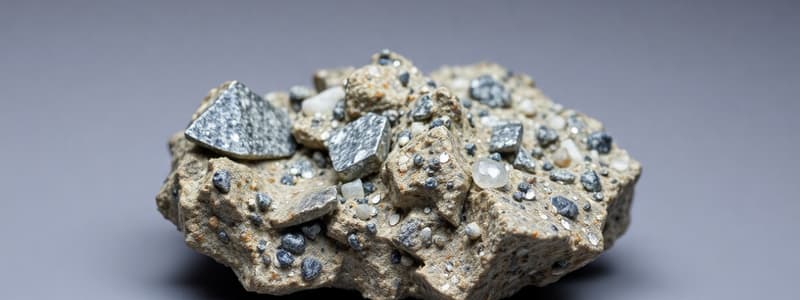Podcast
Questions and Answers
What is density defined as?
What is density defined as?
- The amount of mass in a certain volume of material. (correct)
- The hardness of a mineral.
- The amount of volume in a certain mass of material.
- The color of a mineral.
What happens to an object that is more dense than water when placed in water?
What happens to an object that is more dense than water when placed in water?
- It floats.
- It sinks. (correct)
- It boils.
- It evaporates.
What is specific gravity?
What is specific gravity?
- The ratio of a mineral's mass to the mass of an equal volume of water. (correct)
- The mass of a mineral.
- The color of a mineral compared to water.
- The volume of a mineral.
What is the first step in determining the density of a mineral specimen?
What is the first step in determining the density of a mineral specimen?
How is the volume of a mineral sample determined using water displacement?
How is the volume of a mineral sample determined using water displacement?
What is the formula for calculating density?
What is the formula for calculating density?
If a mineral sample has a mass of 100 grams and displaces 25 cc of water, what is its density?
If a mineral sample has a mass of 100 grams and displaces 25 cc of water, what is its density?
What additional property helped confirm the sample was galena?
What additional property helped confirm the sample was galena?
What are the units for specific gravity?
What are the units for specific gravity?
Which of the following minerals has the highest specific gravity?
Which of the following minerals has the highest specific gravity?
Flashcards
Density
Density
The amount of mass in a certain volume of a material.
Specific Gravity
Specific Gravity
The ratio of a mineral's mass to the mass of an equal volume of water.
Calculating Density
Calculating Density
To find density, divide the mass of the sample by the volume of water displaced.
Water Displacement Method
Water Displacement Method
Signup and view all the flashcards
Galena Identification
Galena Identification
Signup and view all the flashcards
Calculating Specific Gravity
Calculating Specific Gravity
Signup and view all the flashcards
Specific Gravity of Common Rock-Forming Minerals
Specific Gravity of Common Rock-Forming Minerals
Signup and view all the flashcards
Specific Gravity of Gold (24-karat)
Specific Gravity of Gold (24-karat)
Signup and view all the flashcards
Specific Gravity of Platinum
Specific Gravity of Platinum
Signup and view all the flashcards
Study Notes
- Density refers to the amount of mass within a specific volume of a material.
- Specific gravity is a ratio comparing a mineral's mass to the mass of an equal volume of water.
- Density and specific gravity help in distinguishing between different minerals.
Calculating Density
- To determine density, you need the mass and volume of the sample.
- Measure the mass of the mineral sample using a scale, expressed in grams.
- Find the volume by measuring how much water the sample displaces, equal to the sample's volume, expressed in cubic centimeters (cc).
- Density is calculated as: density = mass / volume of water displaced.
- As an example, a sample of 150 grams that displaces 20 cc of water has a density of 7.5 grams/cc.
- Comparing the calculated density to reference materials can aid in mineral identification.
- Density alone may not be definitive, so consider other properties like luster for accurate identification.
Calculating Specific Gravity
- Specific gravity is the ratio of a sample's mass to the mass of an equal volume of water.
- If a sample density is 7.5 grams/cc, then the specific gravity is 7.5.
- One cubic centimeter (or milliliter) of water has a mass of 1 gram.
- To find specific gravity, divide the mass of the sample by the mass of the same volume of water.
- For example, using the previous sample, specific gravity = 150 grams (sample) / 20 grams (water) = 7.5 (no units).
- Specific gravity is a dimensionless value, as the units cancel out.
- Common rock-forming minerals typically exhibit a specific gravity between two and three.
- Quartz has a specific gravity of 2.65.
- Metallic minerals have a much greater specific gravity.
- Gold (24-karat) has a specific gravity around 20.
- Platinum has a specific gravity of about 22.
- Graphite and gypsum are examples of less dense minerals with specific gravities just over two.
Studying That Suits You
Use AI to generate personalized quizzes and flashcards to suit your learning preferences.




